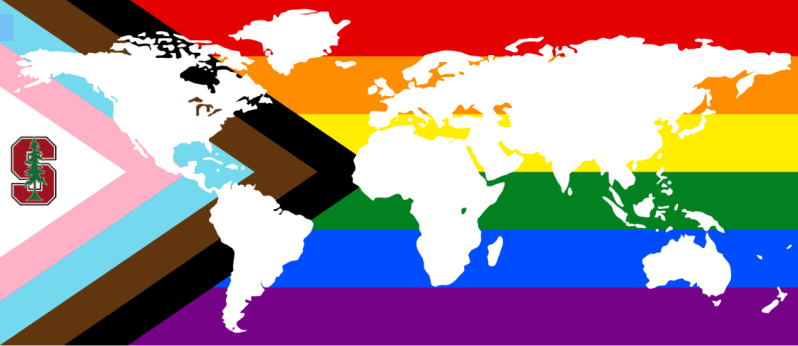At the heart of Silicon Valley, Stanford University stands as a beacon of progressive values. Many international queer students envisioned finding a utopian community — a place where the complexities of their identity would be celebrated, not just tolerated. For those who come from countries with restrictive or seemingly homophobic laws, Stanford appears as a haven, a dreamlike escape from the harsh realities back home. But the reality here is more layered and, in some ways, unexpectedly disorienting.
Upon arrival at Stanford, I expected a culture of inclusivity and acceptance. However, as days turned into weeks, months and then entire quarters, I started to grapple with new challenges that have reshaped my understanding of queer spaces. Back home, despite oppressive laws and societal norms, there was a sense of solidarity and authenticity in the fight for queer acceptance — a straightforward battle against external prejudices. However, at Stanford, the struggles are more complex, especially for those of us who identify as people of color.
At Stanford, fetishization and exoticization often became disturbing undercurrents in my romantic interactions. Whether through dating apps or in social spaces, I’ve noticed that aspects of my identity are often objectified, reducing the complexity of who I am to mere fantasies of my partner. More specifically, as a Black international student, my queer interactions often entail being reduced to the perceived size of my penis or being thought of as exotic.
This issue is not unique to me. A queer international student I spoke to said that, “Using dating and hookup apps on campus, and then being blocked by peers after sending a face pic, is truly one of the most humbling experiences one can endure. What’s worse is that my body is racially ambiguous in a way my face is not. So, people who initially express interest in my body often block me after seeing my face.”
Another student shared a sad and embarrassing experience where their date admitted to not being genuinely interested in them. The date revealed having a preference only for Asian and white men. They commented that they only came on the date with them for amusement.
The fact of the matter is that Stanford is no utopia. There exist deeply entrenched problems within its queer community — all of which are rooted in “sexual racism.”
Coined by Charles Herbert, sexual racism entails the exclusion, rejection and devaluation of individuals based on their race or ethnicity in romantic and sexual relationships. The queer community at Stanford is marked by implicit rules that deem certain races as more desirable than others. This establishes a racial hierarchy of attraction, where whiteness is seen as the highest echelon of attractiveness, thus making those who resemble this standard more favored.
While some queer international students possess Eurocentric features that allow them to be subservient to this racial hierarchy of attraction, many of us don’t. Accordingly, fetishism and exoticism have become the prevalent means by which we are included in the queer romantic space. And if we don’t align with the stereotypes associated with our respective racial identities, we are excluded. It is no surprise then to often find queer students of color actively combating sexual racism on their dating profiles. This reality for queer students of color, domestic and international alike, not only undermines the principles of diversity, equity and inclusion that Stanford claims to strive for, it also shows the internalized racial hierarchies that challenge the very notion of unity within the Stanford queer community.
Research indicates that sexual desires are often influenced by larger social constructions of race, which make up the very foundation of American society. Therefore, I don’t think the sexual racism in Stanford’s queer community will end anytime soon. However, I do believe in being the change you want to see. Thus, to tackle sexual racism in Stanford’s queer community, I think that students should adopt the Kantwon Rogers approach, which entails the following three things:
- Reflect. Reflect on your own racial biases. Think hard about their roots and how they might be unfairly grouping entire races and engage in much self-reflection. Also, look at your friend groups and ask whether they’re diverse. If not, what’s stopping them from being diverse?
- React. React when you hear your queer friends and family say something that just doesn’t sit right, something that reeks of bias or racism — don’t hold back. Speak up and challenge them to think about the impact of their words.
- Remember. Constantly remind yourself about the harm your biases can cause, intentional or not. And I personally encourage this, because as a person of color, it is especially tough for us who face these issues every day. We shouldn’t be the only ones trying to change the narrative. As Rogers points out, the burden of enduring continuous “racial bullets” is immense. So, remind yourself: It’s on all of us — every one of us at Stanford — to be aware and actively work toward creating a more inclusive, respectful queer community.
I’ve reconciled with the idea that my Stanford experience is a lesson in the complexity of queer spaces. I do love the queer community here; however, I’ve come to understand that no community, no matter how seemingly progressive, is free from contradictions. Therefore, while the challenges queer international students might have faced at home were more overt, there still exist many problems that plague the queer community at Stanford. Our struggle transcends geographical and cultural boundaries, and because of this, regardless of where we are, we need to come together, stand united and strive for meaningful change. Knowing this has deepened my perspective on queer rights. It is up to us to change the way we approach each other.
Let’s step up and try to make a real difference.
